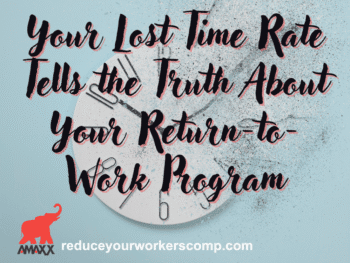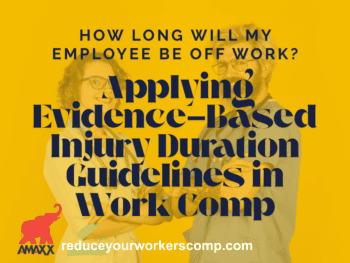
What Are Injury Duration Guidelines?
Injury Duration Guidelines provide evidence-based timelines for recovery from workplace injuries and illnesses. These timelines, established through extensive research and clinical expertise, act as benchmarks for the expected duration of treatment and disability. By setting clear expectations, these guidelines help manage claims efficiently, promote recovery, and ensure equitable treatment for injured workers.
Why Do Injury Duration Guidelines Matter?
1. Setting Clear Expectations
Injury Duration Guidelines establish realistic recovery timelines for injured workers, employers, and medical providers. This clarity reduces uncertainty and helps all parties plan effectively for treatment, return-to-work programs, and workload adjustments.
2. Promoting Recovery
Evidence-based timelines ensure that injured workers receive appropriate treatment without unnecessary delays or interventions. By aligning care with proven recovery pathways, these guidelines foster a quicker return to normal activities and reduce the risk of complications or prolonged disability.
Click Link to Access Free PDF Download
“13 Research Studies to Prove Value of Return-to-Work Program & Gain Stakeholder Buy-In”
3. Ensuring Fairness
In a system as diverse as workers’ compensation, consistency is key. Injury Duration Guidelines provide a standardized approach to assessing claims, reducing the variability that can arise from subjective decision-making. This consistency promotes fairness and enhances trust in the system.
4. Managing Costs
Prolonged claims can lead to escalating medical expenses and lost productivity. By providing clear benchmarks for recovery, Injury Duration Guidelines help prevent unnecessary treatments and reduce claim durations, benefiting both employers and insurers.
Key Features of Effective Injury Duration Guidelines
Evidence-Based
Effective guidelines are grounded in the latest medical research and clinical data, ensuring they reflect current best practices.
Customizable
While guidelines provide standardized timelines, they also account for individual factors like age, pre-existing conditions, and job demands. This flexibility ensures that care is tailored to the unique needs of each worker.
Comprehensive
Injury Duration Guidelines cover a wide range of injuries and illnesses, from minor sprains to complex fractures. Their breadth makes them a valuable resource for managing diverse claims.
Accessible
Guidelines should be easy to understand and use, enabling stakeholders—medical providers, employers, and claims adjusters—to apply them effectively in their decision-making processes.
Practical Applications of Injury Duration Guidelines
1. Return-to-Work Planning
Guidelines provide a roadmap for determining when an injured worker is ready to resume duties, whether in a full or modified capacity. By aligning return-to-work decisions with evidence-based timelines, employers can avoid premature returns or unnecessary delays. The ACOEM 3-Part Return-to-Work Framework can further enhance these efforts by offering structured approaches to this critical aspect of claims management.
2. Claims Management
For claims adjusters, Injury Duration Guidelines serve as a critical reference point for evaluating the appropriateness of treatment plans and estimating claim durations. This helps streamline case management and improve outcomes.
3. Provider Accountability
Medical providers can use the guidelines to validate treatment plans and ensure they align with established standards. This promotes accountability and enhances the quality of care.
4. Worker Engagement
Clear timelines help injured workers understand what to expect during their recovery journey. This transparency fosters engagement, reduces anxiety, and encourages active participation in the rehabilitation process.
FREE DOWNLOAD: “13 Research Studies to Prove Value of Return-to-Work Program & Gain Stakeholder Buy-In”
Overcoming Challenges in Using Injury Duration Guidelines
While the benefits of Injury Duration Guidelines are significant, their implementation can face challenges. Some stakeholders may resist standardized approaches, viewing them as overly rigid or restrictive. Additionally, guidelines must be regularly updated to reflect advances in medical science and evolving workplace demands.
Education and Training
Providing training on the value and application of Injury Duration Guidelines can help address resistance and ensure consistent usage across teams.
Technology Integration
Digital tools can make guidelines more accessible and user-friendly, enabling seamless integration into claims management systems and medical decision-making workflows.
Ongoing Updates
Commitment to regular updates ensures that the guidelines remain relevant and continue to reflect the latest evidence and best practices.
Conclusion
Injury Duration Guidelines are a cornerstone of effective workers’ compensation management, offering a clear, evidence-based framework for recovery and claims resolution. By promoting consistency, fairness, and efficiency, these guidelines benefit everyone involved—injured workers, employers, medical providers, and insurers alike. Light-duty is also integral in supporting injured workers during their recovery phase. As the industry evolves, embracing and refining these guidelines will be key to fostering better outcomes and creating a more resilient workers’ compensation system.

Contact: mstack@reduceyourworkerscomp.com.
Workers’ Comp Roundup Blog: http://blog.reduceyourworkerscomp.com/
Injury Management Results (IMR) Software: https://imrsoftware.com/
©2024 Amaxx LLC. All rights reserved under International Copyright Law.
Do not use this information without independent verification. All state laws vary. You should consult with your insurance broker, attorney, or qualified professional.

















